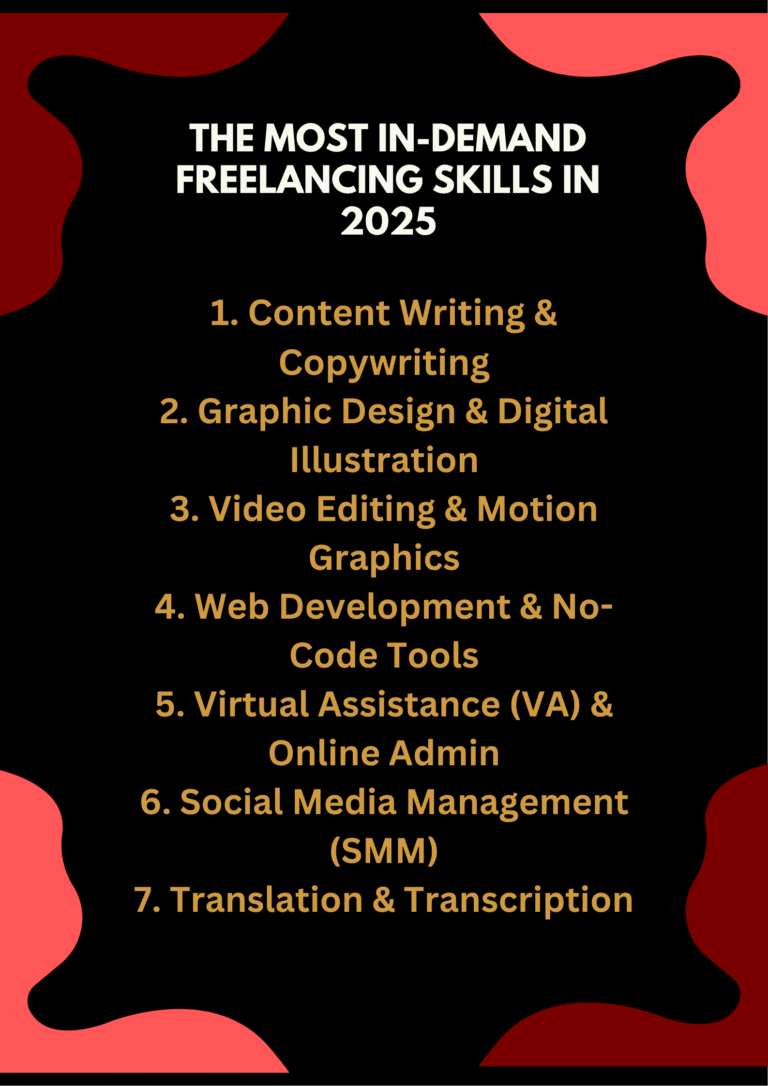“Explore the top freelance skills clients are hiring for in 2025—and how you can start learning them today.”

aisha arif
June 8, 2025

Skill development is the foundation of success in the freelance economy. Whether you’re just starting out or aiming to level up your career, knowing the most in-demand skills for freelancing in 2025 can give you a powerful edge. In this blog, we’ll explore the freelance skills that are currently most sought-after by clients—and help you choose the right one based on your strengths and goals.
To explore what’s trending in real time, check out FreeUp’s latest roundup of the Top 10 Most In-Demand Skills for Freelance in 2025, offering a clear view of what services are actually being hired for right now.
 The most in-demand skills for freelancing in 2025
The most in-demand skills for freelancing in 2025
1. Content Writing & Copywriting
Potential Revenue: ₹10,000 to ₹1,00,000/month (or more depending on clients and projects)
Words still rule the internet—and businesses rely heavily on skilled writers to create compelling blogs, website content, product descriptions, and email campaigns. If you love storytelling, explaining ideas clearly, or persuading with words, freelance writing is a powerful niche to explore.
Top niches: SEO blog writing, e-commerce product copy, scriptwriting, and email marketing.
Ideal for: Students, homemakers, and anyone with a strong command of English or their native language.
2. Graphic Design & Digital Illustration
Potential Revenue: ₹5,000 to ₹2,00,000+/month based on skill and brand quality
Visual content is gold. From logos to social media posts and eBooks to packaging, design is everywhere.
Tools to learn: Canva (easy start), Adobe Illustrator, Procreate, Figma.
Good for: Creatives, teens with a flair for aesthetics, and artists looking to shift to digital.
3. Video Editing & Motion Graphics
Potential Revenue: ₹15,000 to ₹2,50,000/month depending on complexity
Video is dominating content formats across platforms. Editors are needed for YouTube, Instagram Reels, online courses, and brand ads.
Tools to learn: CapCut, Adobe Premiere Pro, DaVinci Resolve, After Effects.
Good for: Tech-savvy individuals, gamers, YouTubers, and digital creators.
4. Web Development & No-Code Tools
Potential Revenue: ₹25,000 to ₹3,00,000/month (even more with clients from abroad)
Websites are essential for every business. You can learn coding (HTML, CSS, JS) or build using no-code platforms like Webflow, WordPress, or Shopify.
Good for: Tech lovers, logical thinkers, teens, and even retired IT professionals.
5. Virtual Assistance (VA) & Online Admin
Potential Revenue: ₹8,000 to ₹50,000/month
Every busy entrepreneur or small business needs support—email handling, managing bookings, customer support, or research. You don’t need to be technical, just organized and communicative.
Good for: Stay-at-home parents, part-timers, and anyone good at multitasking.
6. Social Media Management (SMM)
Potential Revenue: ₹10,000 to ₹80,000/month (per client)
From content calendars to hashtags and captions—brands want to be seen. If you’re active on Instagram, LinkedIn, or Pinterest, use your skills to help others grow.
Good for: Teens, young adults, homemakers, or influencers.
7. Translation & Transcription
Potential Revenue: ₹5,000 to ₹60,000/month
If you speak multiple languages or can type out audio into text, this is a niche for you. With global content exploding, multilingual freelancers are in high demand.
Good for: Language learners, multilingual seniors, students from regional backgrounds.
These skills aren’t just guesses — they’re based on actual data. Upwork’s 2025 list of most in-demand freelance skills highlights exactly where clients are investing.
Mastering these skills is just the beginning — using the right tools can help you deliver faster and better. Check out Work Smarter, Not Harder with the Best AI Tools for Freelancers to supercharge your freelance workflow.
 Where’s the Money? (Revenue Breakdown)
Where’s the Money? (Revenue Breakdown)
Whether you’re just starting out or ready to scale, freelancers typically earn through these three core methods:
1. Hourly or Project-Based Work
Platforms like Fiverr, Upwork, and Freelancer let you offer services and get paid per task or by the hour. Ideal for beginners building experience and reviews.
2. Retainer Clients
These are ongoing, monthly contracts—perfect for steady income. Think managing social media, writing weekly blog posts, or handling customer emails.
3. Selling Digital Products
Once you master a skill, turn it into passive income. Create and sell templates, eBooks, digital presets, or mini-courses.

EEAT – Why You Can Trust This Guide (Even If I’m Still New)
Let’s be real—I’m not a big influencer or full-time freelancer (yet). But here’s what I bring to the table:
E (Expertise): I’ve spent 2 years actively researching freelancing—what works, what doesn’t, which skills pay, and how beginners like us can get started from scratch.
E (Experience): While I haven’t worked with clients yet, I’ve been learning from real case studies, online freelancers, blogs, YouTube creators, and free course platforms. Everything I share here is based on what’s working today, not outdated theory.
A (Authority): I’m documenting this journey as a student and beginner, so my advice is practical and relatable—especially if you’re just getting started too.
T (Trust): I’m not selling you a course or making fake income claims. I only recommend skills and platforms that are beginner-friendly, free (or low cost), and real.
 How to Start Freelancing at Any Age – My Personal Advice
How to Start Freelancing at Any Age – My Personal Advice
 If You’re a Student (13–22 yrs)
If You’re a Student (13–22 yrs)
Start small: design logos, write articles, manage Instagram for local brands.
Build a portfolio using free platforms (Behance, Dribbble, Medium).
Don’t undercharge but don’t overthink either—start with ₹200–₹500 gigs.
 If You’re a Homemaker or Parent (25–45 yrs)
If You’re a Homemaker or Parent (25–45 yrs)
Use your time management and multitasking as a strength.
VA, writing, design, and social media are great low-investment skills.
You can work part-time without affecting your home life.
 If You’re 45+ or Retired
If You’re 45+ or Retired
Your life and work experience are high-value assets.
Consider offering consulting, admin support, teaching, or translation.
Use platforms like LinkedIn and Facebook groups to find freelance communities.
 Final Tips Before You Begin
Final Tips Before You Begin
Pick 1 Skill → Learn It → Master It
Don’t jump into five things. Start focused.Build a Portfolio
Even unpaid sample work can help build credibility.Join a Platform
Start with Fiverr, Freelancer, or even local WhatsApp groups.Keep Learning
Free courses (Coursera, YouTube, Skillshare) are your best friends.Be Patient and Consistent
The first client is always the hardest. But the journey is 100% worth it.
 Conclusion: Your Skills, Your Freedom
Conclusion: Your Skills, Your Freedom
Freelancing is not just a side hustle—it’s a pathway to independence. Whether you want to earn pocket money, save for a dream trip, or build a full-time career, there is a place for you.
And remember: you don’t need permission to start—just action.
Final Thoughts: You Only Need One Skill to Begin
After years of researching the modern freelance economy — I can confidently say: You don’t need to do everything. Just do one thing well.
Pick a skill. Learn it deeply. Serve one client at a time.
That’s how I started. That’s how thousands are doing it now.
And that’s how you can start today.
So let me ask you: Which skill will you choose to begin your freelancing journey?
If you have questions, drop them in the comments. I’m here to help every beginner who wants to turn their interest into income — one skill at a time.
Written with love, honesty, and hustle.
Aisha Arif – Building Dreams, One Skill at a Time.
Pingback: Top 5 Easy Freelance Skills Teens Can Learn Online